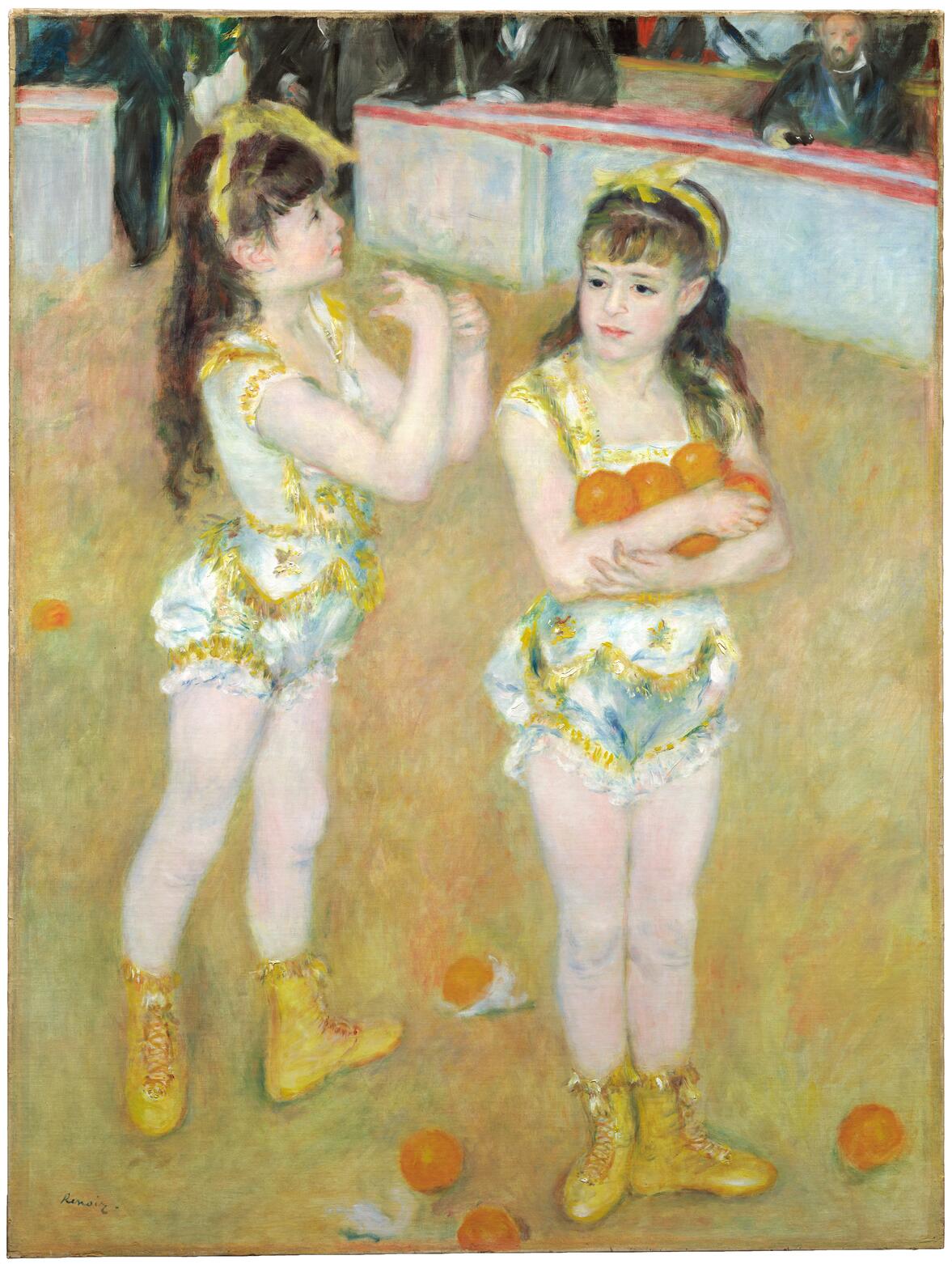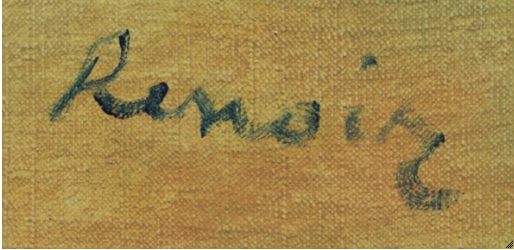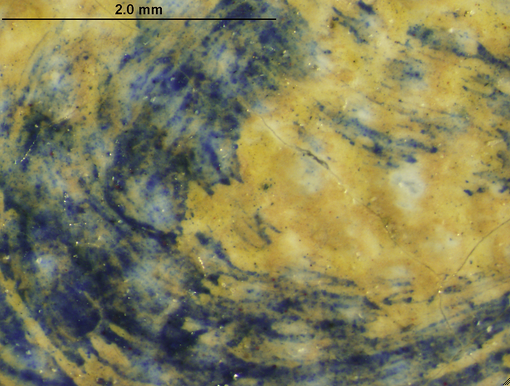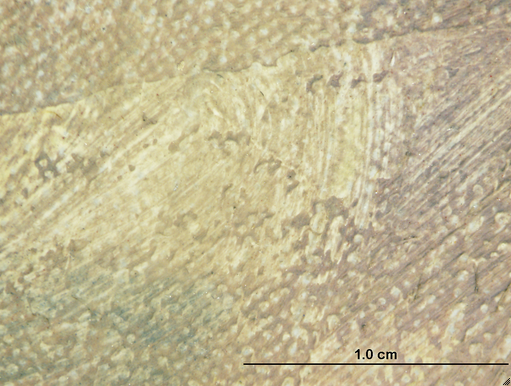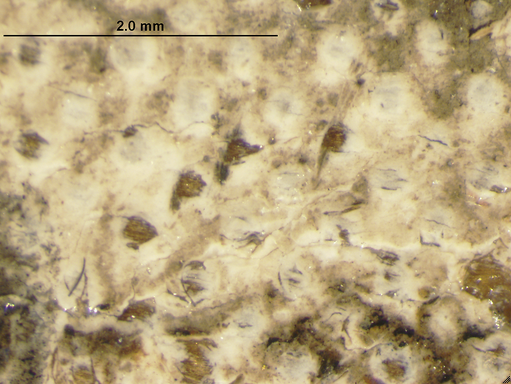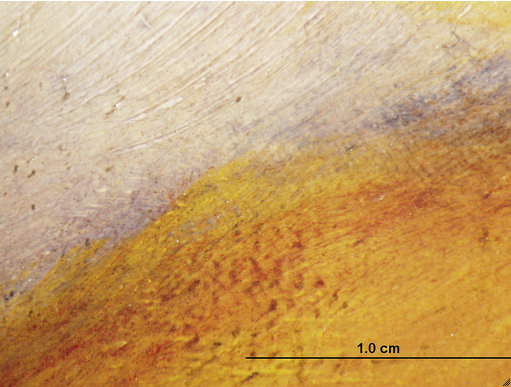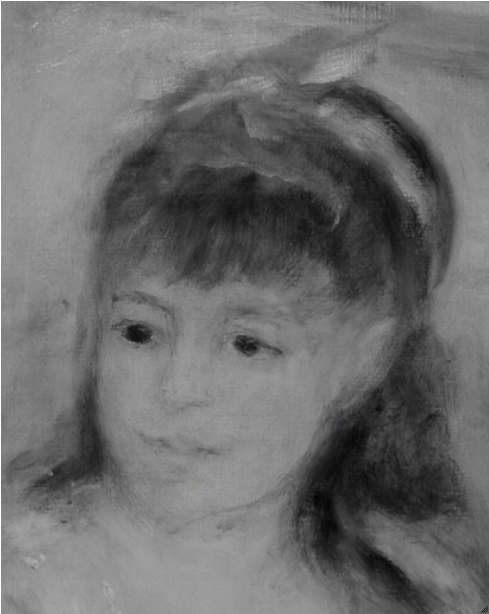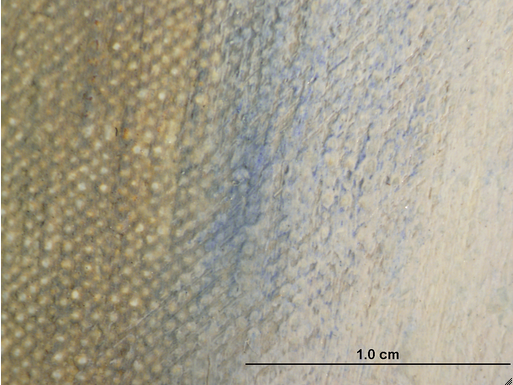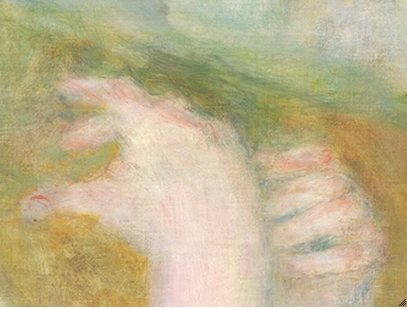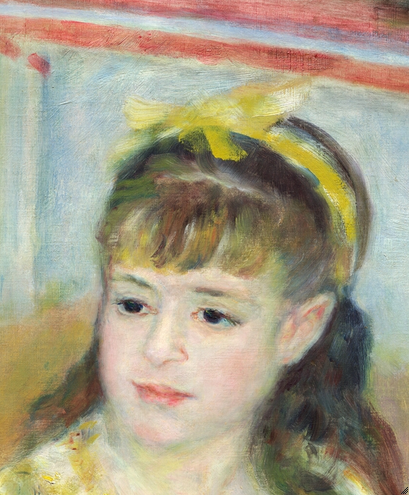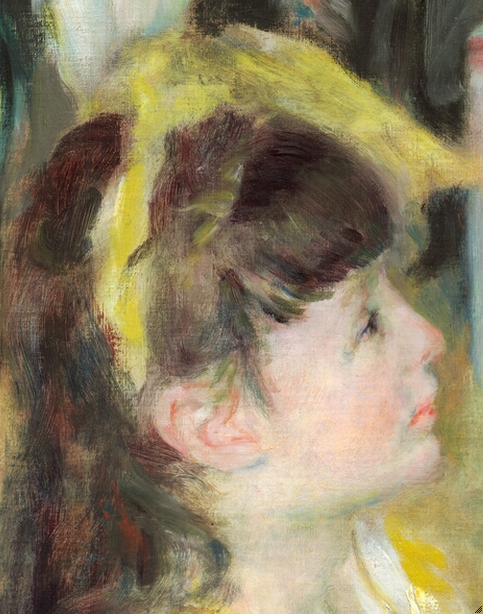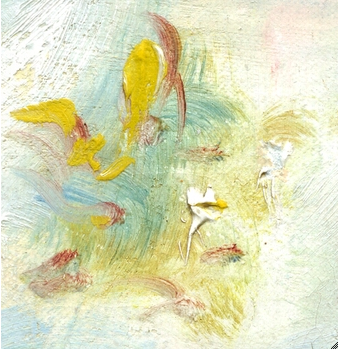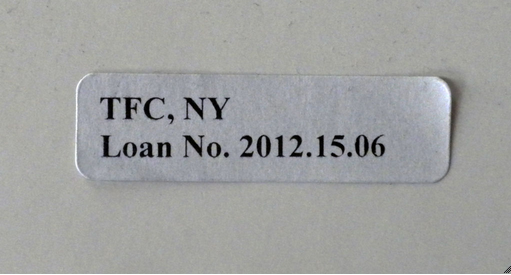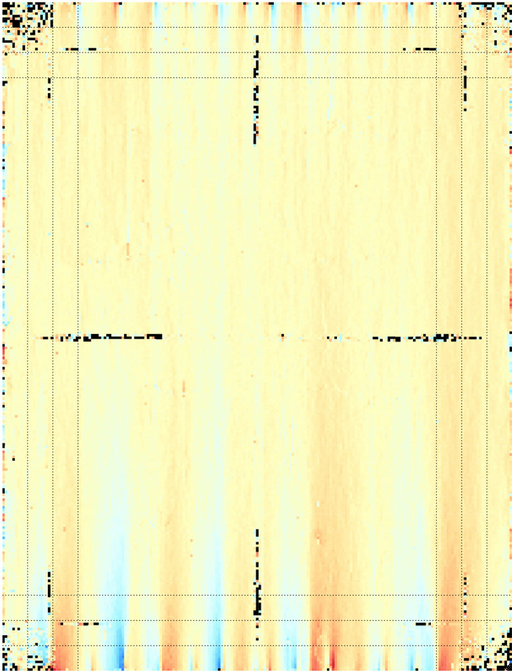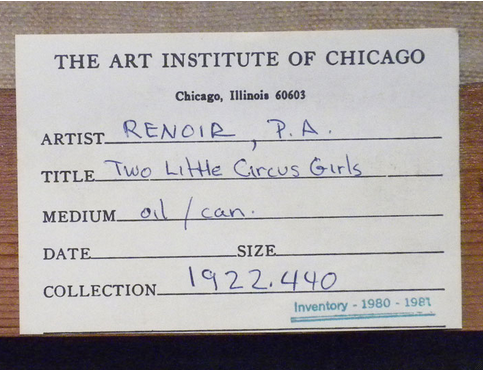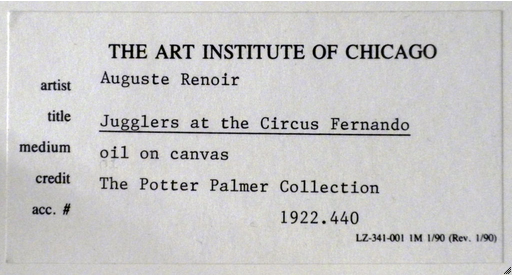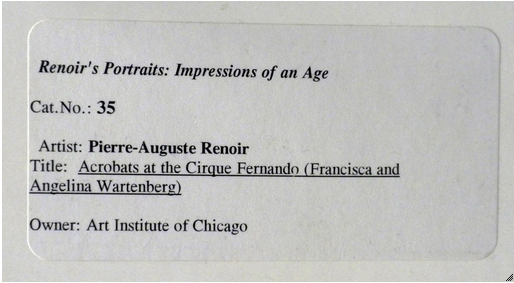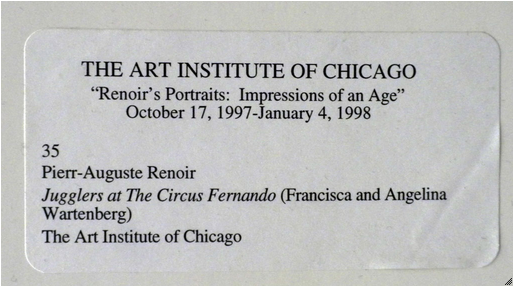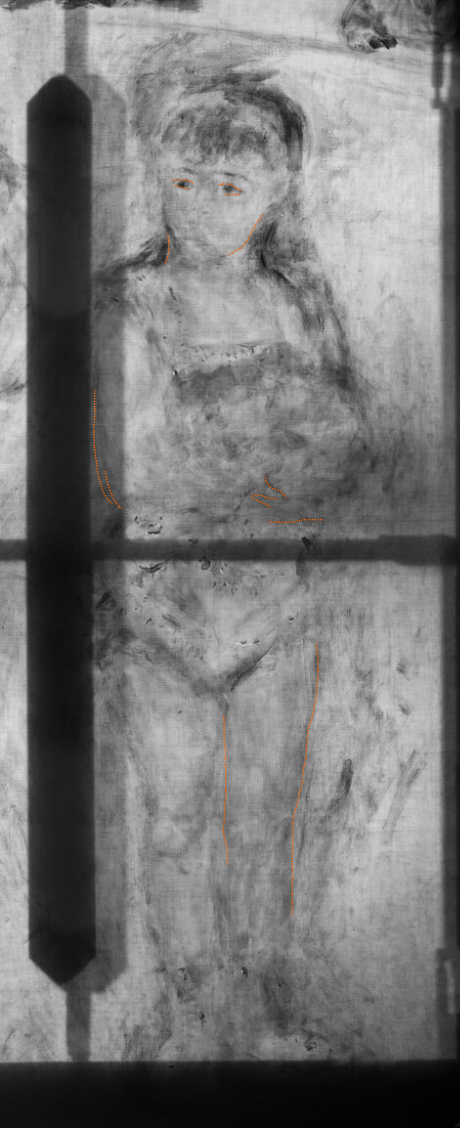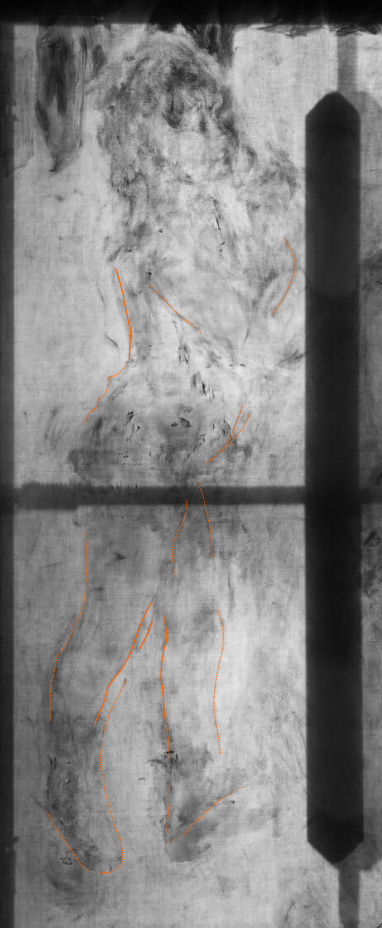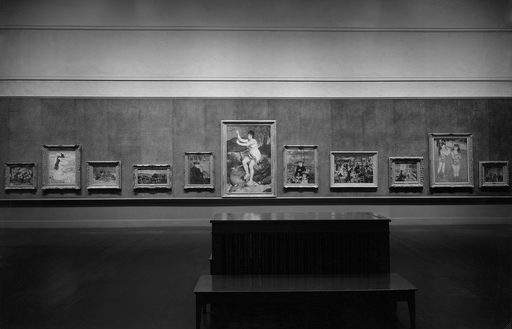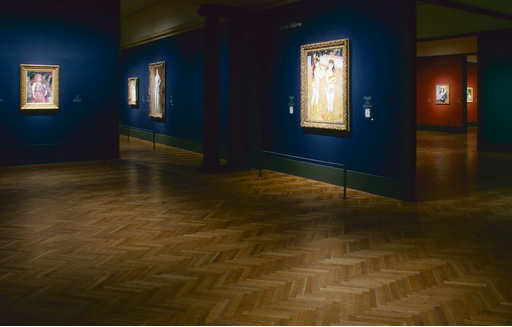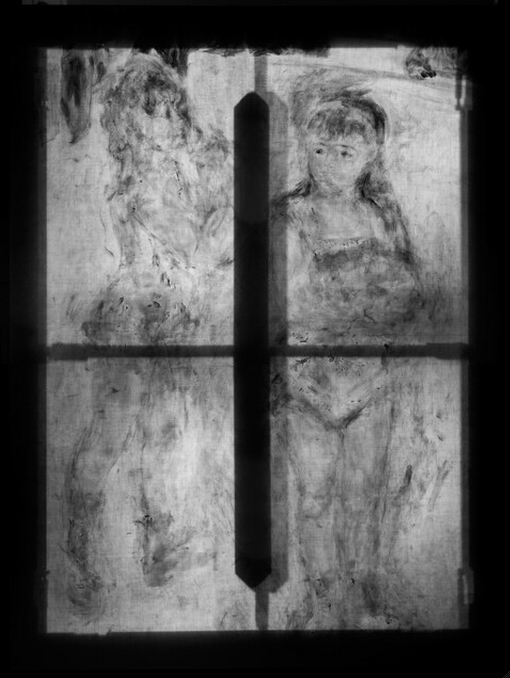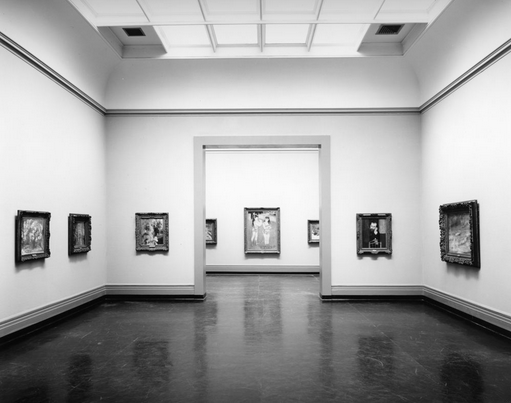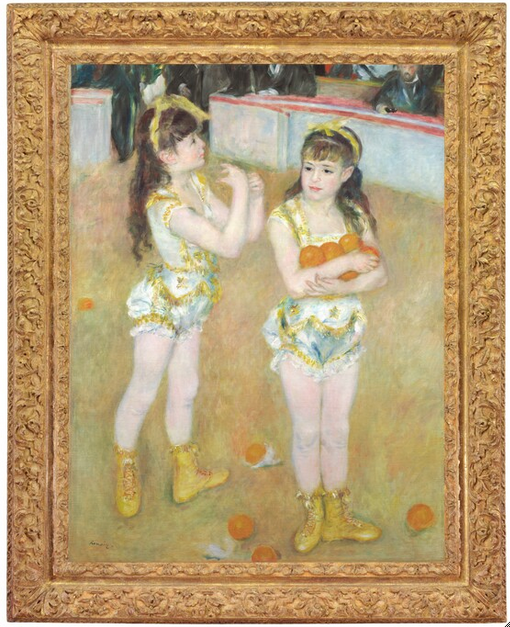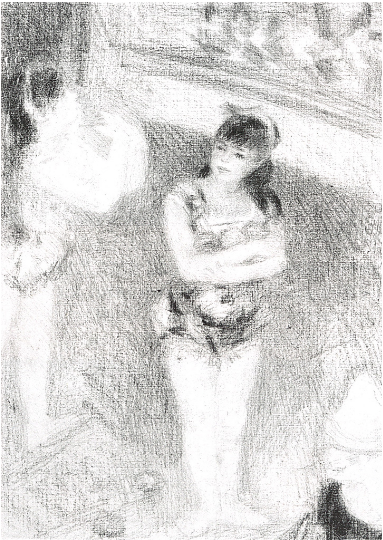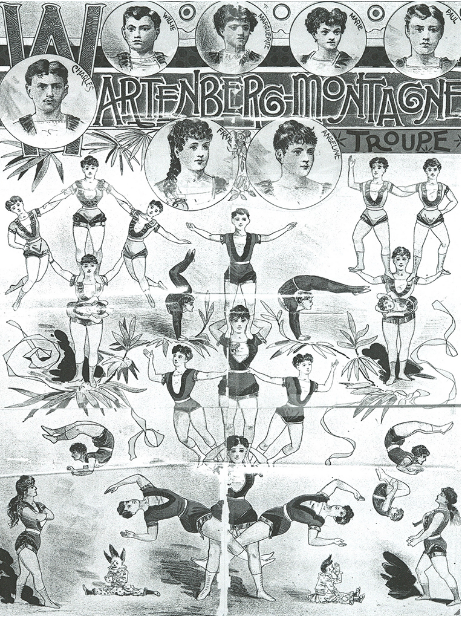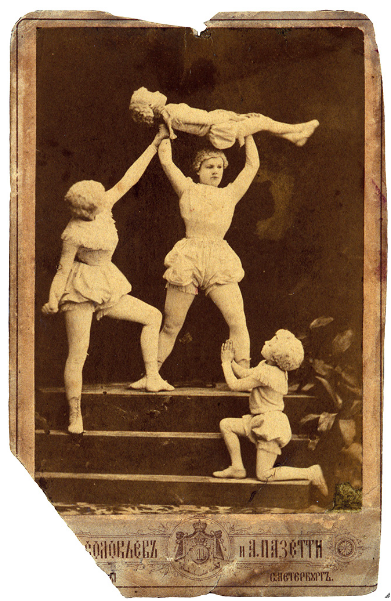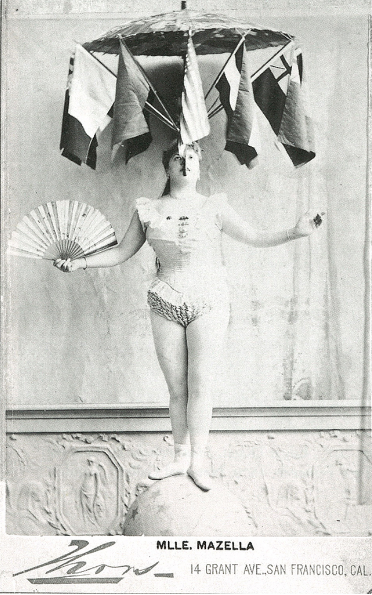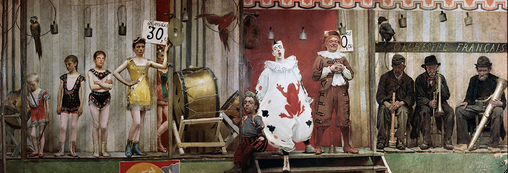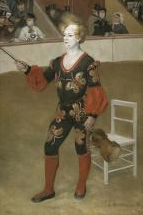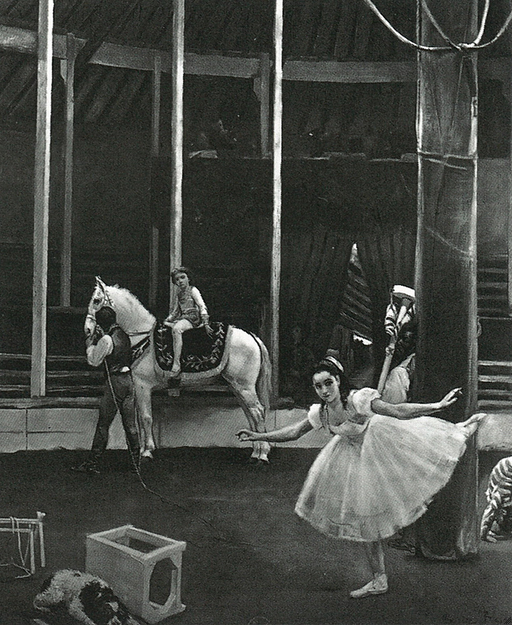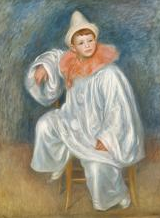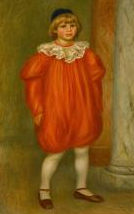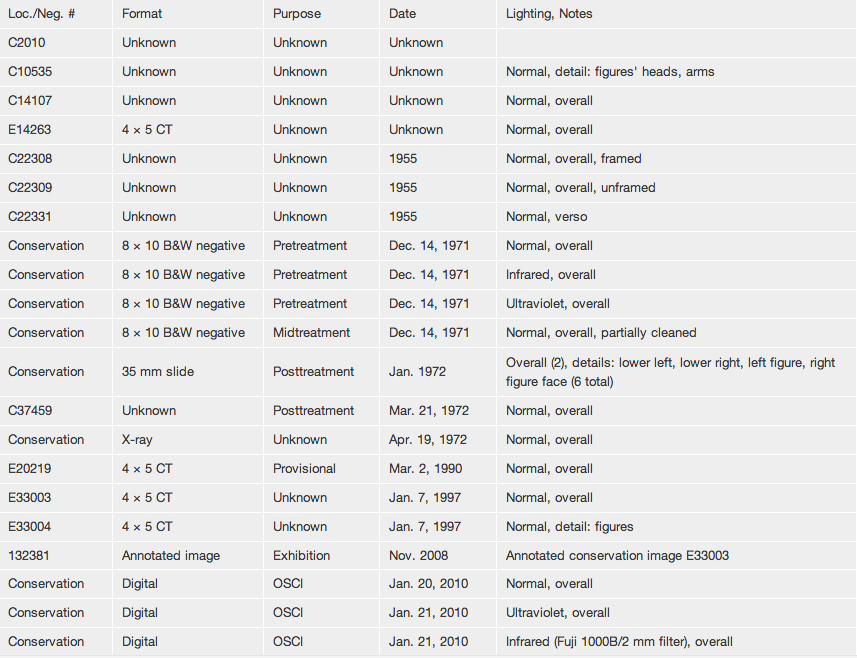The Enigma of Renoir’s Acrobats: Genre Painting or Portraiture?
As a septuagenarian long retired from the circus ring, Angelina Wartenberg, the model for the girl on the right in this painting, wrote in 1938 from her home in London to her niece, Marguerite Streckfus, of San Rafael, California: “I am sending you now a little picture that will interest you [Acrobats]; it is your mother [Francisca] and myself when we were beginning our careers as Circus Kids; the big one is of course your dear Ma, being three years my Senior—so you see, I am the greedy one, and collar most of the oranges the public pelted us with.” In this delightful firsthand account from a Renoir model, Angelina clarified that she and her sister were not jugglers, as the artist’s biographer Georges Rivière identified them in 1921, but rather were participating in a traditional ritual of appreciation shown toward child performers in the circus. This custom was recounted by Edmond de Goncourt in his novel Les frères Zemganno, published in 1879, in which a child gymnast, age five, receives a similar ovation. Until Angelina’s reminiscences became known, the girls’ identities had long been forgotten; indeed, they appear to have been irrelevant to Renoir when he described the work in the early twentieth century to the art dealer Ambroise Vollard as “des fillettes jouaient avec des oranges.” The models may simply have represented for Renoir a generalized subject of leisure entertainment in the Third Republic. Throughout the nineteenth century, clowns and acrobats brought distraction and momentary joy to Parisian audiences. During the 1870s, the Wartenberg girls were just two of a teeming multitude of itinerant circus performers who passed through Paris—to date no notice of their performance has come to light in the daily schedules of circuses that appeared in city newspapers—yet Renoir endowed them with an elegance of form and a sensitivity that is usually associated with portraiture. His models would be forgotten today were it not for the serendipitous introduction of biographical detail in 1938, which transformed Acrobats into a noncommissioned portrait, allowing us to test the accuracy of the artist’s rendering.
The artist’s brother Edmond Renoir attested to the truthfulness of the representation in an article of 1879 for La vie moderne, in which he used the painting’s correct title, Acrobats, and praised it as “authentic to modern life,” though without mentioning the names of the models, their family background, or details of their routine. His comments appeared in a short biographical sketch written on the occasion of an exhibition primarily of pastels held at the office of La vie moderne in June: “Quite apart from its artistic value, his work has all the distinctive charm of an authentic scene of modern life. What he has painted, we see every day; it is our own existence that he records in passages [pages] which will surely remain among the most vivid and harmonious of their time. Thus for the Acrobats the arrangement really doesn’t matter. One could say that by a process of incomprehensible subtlety and instantaneity, he has captured the actual movement of the two children. It’s just the way they walked, bowed, smiled in the circus ring. I will not use big words like realism or impressionism to say that this is real life with all its poetry and all its character.”
This article functions less as a review than as a survey of Renoir’s artistic development. Here we learn for the first time of Renoir’s teenage years as a porcelain painter; of his first painting, Eve and the Serpent; of his debt to artists such as Gustave Courbet and Narcisse Diaz de la Peña. Mention is made of major Renoir paintings including Lise (1867; Museum Folkwang, Essen [Daulte 29 Dauberville 283]), Dance at the Moulin de la Galette (1876; Musée d’Orsay, Paris [Daulte 209; Dauberville 211]), and Madame Georges Charpentier and Her Children (1878; Metropolitan Museum of Art, New York [Daulte 266; Dauberville 239]), a painting then on view at the Salon of 1879, depicting the family of the publisher of La vie moderne. Edmond’s lengthy discussion of Acrobats follows this list of Renoir’s major accomplishments. La vie moderne was an odd choice of venue for the debut of this large painting, which was of a scale one might have expected to see at the Salon. It must have looked out of place among the smaller pastels. A second review in La presse, possibly also written by Edmond under a pseudonym, is only slightly more helpful in describing the exhibition as comprising “about thirty works, portraits in pastel, landscape paintings, decorative sketches.” This second review also highlights the poetic reality (“poésie réelle”) of Acrobats, though it suggests that the satin costumes worn by the girls were originally pink.
Douglas Druick has challenged Edmond’s contention that Acrobats is absent of convention or artifice. The warmth of the flesh tones of the two girls, the luminosity of their pink tights, wrinkled at the knee, and the bright tones of the white and yellow costumes all suggest that they were painted in natural light, rather than the harsh artificial light of the circus arena. Such lighting repelled Renoir because it contorted faces and transformed gestures into distorted caricature. This would imply that while the background may have been painted in situ, at the circus—a hypothesis supported by the accurate yet schematic treatment of the spectators and the environment—the girls themselves may not have been.
While Edmond claimed that his brother portrayed the Wartenberg sisters just as they moved in the circus ring, there is nothing about their poses that conveys how they might have performed. The static appearance of the girls’ positions may be the result of a studio setting. Renoir endowed his young acrobats with all the elegance of ballet dancers in their gestures and postures, which mimic ballet’s third (Angelina) and fourth (Francisca) positions. Renoir’s initial painted guidelines for the legs of the figures, visible in transmitted- and reflected-infrared images of Acrobats (fig. 9.1), suggest that he later adjusted Angelina’s feet so that they overlap slightly and placed Francisca’s left leg farther from her right in order to make this point precisely. Such a portrayal of the Wartenberg sisters is not consistent with the sensationalism and physical daring of their tableau vivant and human pyramid acrobatic acts. Renoir’s presentation of the girls in a way that equates them with the highbrow world of the ballet is a prime demonstration of his “oeil bienveillant,” or what Colin Bailey has referred to as “aesthetic leveling.”
The elegant poses and full-length treatment of the figures in Acrobats recall Renoir’s earlier painting of an aspiring child performer, The Dancer (fig. 9.2) [Daulte 110; Dauberville 493]), exhibited at the first Impressionist exhibition, which opened in April 1874. With dimensions of 142.5 × 94.5 cm, The Dancer is just eleven centimeters taller and five centimeters narrower than Acrobats, which was executed on a no. 60 portrait (figure) standard-size canvas. Renoir’s ballerina appears to be a younger trainee known as a “rat de l’Opéra,” commonly of an age between eight and fourteen. In Acrobats Renoir drew on the same strategy of harmonized color application throughout the canvas that he used in The Dancer, which is dominated by cooler tones—blues and greens, with blue accents in the shadows of the shimmering white ballet costume. Acrobats was rendered in a contrasting palette of mostly yellows and oranges. The costumes of the two Wartenberg girls, from the yellow boots to the tassels and stars to the ribbons in their hair, serve to establish a color theme. Renoir then developed the color harmonies in the extensive use of yellow in the arena floor, which acts essentially as a diaphanous background of the kind he presented in The Dancer.
Additional evidence exists that Renoir’s portrayal departs from the actual circumstances of the girls’ performance. A rare preliminary study for Acrobats, a chalk drawing executed on canvas, includes a clown in the bottom right (fig. 9.3), and, in fact, the two young girls likely would have shared the arena with other circus acts. The absence of the clown in the painting and the centering of the Wartenberg sisters in the composition subdue the ribald ambience of the circus in order to better focus on the girls’ contentment and pleasure at collecting the oranges, thus giving this circus genre painting a stronger emotional impact. It is evident from the drawing that Renoir had already decided on the raised point of view with its limited details of the circus arena and the unusual balletic poses. In the painting, the circus-ring wall is taller and closer to the top of the composition, eliminating all but one of the spectators’ faces and leaving only the legs of the staff and other performers waiting their turns, thus further distancing the children from the boisterous adult realm of the circus arena.
The Wartenbergs: Memorializing an Itinerant Circus Troupe
Francisca and Angelina were the eldest siblings in a family of Franco-German gymnasts. There were seven Wartenberg children by the mid-1880s, all of whom collaborated in performances such as “le Montagne,” a variation on the human pyramid (fig. 9.4). As anchors for the pyramid, Angelina and Francisca were of a robust and muscular build by that time, much more physically developed than their diminutive likenesses in Renoir’s painting. A promotional photograph of the Wartenberg children performing in Saint Petersburg, possibly from 1880, shows the two older girls with two of their younger siblings, who appear to be about five or six years old (fig. 9.5). In this photograph, Angelina and Francisca look more mature than they do in the painting. As the two appear alone in Renoir’s Acrobats, presumably either none of their siblings were old enough to participate in the act, or the two were performing as a duo on that occasion.
Angelina was baptized in Berlin on March 13, 1864, by her parents, Carl Richard Ludwig Wartenberg, “Gymnastischer Künstler,” and Joséphine Hermine Wartenberg, née Decamps. While Angelina stayed in London after the family became naturalized British citizens in 1889, Francisca sought opportunity as a circus performer in the United States (fig. 9.6) where she eventually married George Sebastian Miehling, a “professional instructor” at the Olympic Club of San Francisco.
Variously ascribed dates from 1868 to 1882 within Renoir’s lifetime, the current accepted dating of Acrobats to 1879 (based on the painting’s first appearance at exhibition) would mean that Angelina and Francisca are shown at the ages of fourteen and seventeen, respectively. Earlier references to the painting suggest that the models were perceived as younger. In her 1938 letter to her niece, Angelina stated that Renoir portrayed the sisters as “Circus Kids” at the beginning of their careers. In 1879 Edmond Renoir referred to the girls as “enfants” in his review in La vie moderne, and Paul Durand-Ruel recorded the painting’s title as Les petites acrobates when it was deposited by Renoir in April 1881. Renoir himself referred to them as “fillettes” (little girls)—a term not usually applied to postpubescent teenagers. Acquired by Potter Palmer from Durand-Ruel in May 1892 as Dans le cirque, the painting carried the title Two Little Circus Girls for more than fifty years in the collection of the Art Institute of Chicago. The firm handling of the figures, the signature, the elevated point of view, and the thematic emphasis on the color yellow all point to Renoir’s Impressionist style of the later 1870s, such as that seen in Mussel Fishers at Berneval (fig. 9.7 [Daulte 292; Dauberville 215]). Clearly the lighting and the elegance of the poses of the two models were not the only aspects of the painting with which Renoir took license.
Angelina’s letter of 1938 suggests that the Wartenberg family enjoyed a happy and thriving life in the circus. This was not the case for other circus troupes that included young children. Fernand Pelez’s Grimaces and Misery (The Saltimbanques), shown at the Salon of 1888 (fig. 9.8), is a sad testimony to the common exploitation of children, who were often unwillingly pressed into a life of grinding poverty and long hours. Pelez practiced a style of Realism compatible with the novels of Émile Zola, who often wrote about the harsh conditions of urban living for the lower classes. In his description of his brother’s painting Acrobats as “real life with all its poetry and character,” Edmond pointed to an alternative kind of Realism, one that sought beauty and dignity in those conditions and in the most lowbrow of popular distractions. Edmond de Goncourt made the same argument when he called for a “roman réaliste de l’élégance” in the preface to Les frères Zemganno. In creating a circus performer who was a sympathetic figure with complex emotions, Goncourt followed the example of writers such as Charles Baudelaire and the Parnassian poet Théodore de Banville, who endowed the circus theme with a new level of literary significance.
Renoir at the Circus
In 1868 Renoir departed from his usual routine of preparing large-scale paintings for the Salon to fulfill a request from a café owner at the Cirque Napoléon (today the Cirque d’Hiver) for a portrait of the clown James Bollinger Mazutreek (fig. 9.9 [Daulte 38; Dauberville 230]). The Impressionists were often drawn to the circus as a subject of modern life, but in this painting the artist did not convey the spectacle of performance. Rather, in the calm poise of Mazutreek’s bearing and the outstretched gesture of his bow arm, Renoir presented the performer in a pose that recalls the Apollo Belvedere (albeit an unusually frizzy-haired version), just as he later elevated the popular context of Acrobats by showing it through the lens of high art. The natural light in which the Wartenberg sisters are portrayed sets Acrobats apart from the earlier Clown, in which Mazutreek’s painted white face gives off an eerie luminosity, while his dark, butterfly-bedecked costume and the dull brown of the circus floor absorb rather than reflect the light. In both circus paintings, Renoir altered how the subject was generally viewed. As his brother Edmond asserted, Renoir created a “poetic reality” out of the discordant atmosphere of the circus ring. In doing so, he drew on his gifts as a portrait painter to see beyond the thespian mask, thus drawing attention to the acrobats as sensitive individuals.
The year 1875 marked an important milestone in French circus history, with the completion in June of the Cirque Fernando’s permanent building in Montmartre at the corner of the boulevard de Rochechouart and the rue des Martyrs, just a short walk from Renoir’s rue Saint-Georges studio. Though never specifically identified as such during Renoir’s lifetime, it is likely that the Cirque Fernando is the setting for Acrobats. From 1873 to 1875, the Cirque Fernando operated at the site under a temporary tent supported by a timber structure strong enough to hold a musician’s box; this box can be seen in Maurice Blum’s Rehearsal at the Cirque Fernando, which was accepted to the Salon of 1874 (fig. 9.10). The multiple figures shown at work in this painting provide evidence that individual performers often shared the arena with other acts or roaming clowns.
Acrobats is not simply a return to a favorite leitmotif, or a variation on the theme of popular culture; it can be interpreted as a parable of childhood experience in the commercial world of leisure in nineteenth-century Paris. The appearance of children in Renoir’s Impressionist work often symbolizes the same joy and happiness he intended to convey with the presence of sunlight. It is significant that, in returning to the subject of the circus later in life, he chose to portray his own sons—Jean as Pierrot (fig. 9.11 [Dauberville 2390]) and Claude as a clown (fig. 9.12 [Dauberville 3455]), at the ages of seven and seven or eight, respectively—as if the world of the funambule were a rite of passage. These portraits depict whimsical, costumed role-playing, but they also evoke Renoir’s working-class roots and a youth spent enthralled by the theatrical life of the boulevard du Temple.
John Collins
Technical Report
Technical Summary
Renoir began this painting with a large, no. 60 portrait ([glossary:figure]) standard-size canvas with a commercially applied white [glossary:ground]; a [glossary:radio-opaque] area in the [glossary:X-ray] as well as areas of visible palette-knife texture may indicate that either the artist or the [glossary:color merchant] added more ground material locally or overall to the compositional area. Renoir executed a gestural contour drawing of the figures in deep-blue paint, making many alterations and adjustments to each figure before settling on the final composition. There are also indications that finer drawing, perhaps in [glossary:graphite], is present in the faces of the figures. The figure on the right appears to have been more forward-facing and slightly bent at the waist, while the figure on the left may have stood with her legs closer together, slightly to the left of their current position, and with a more arched back and curved arms. Though some of these changes were painted out, others (such as the hands of the figure on the left) remain visible under normal viewing conditions due to the translucence of the background paint. In the background and upper portion of the composition, thinned [glossary:oil] paint, translucent [glossary:pigments] such as red lake, and the artist’s use of wiping and scraping combine to create an overall lightness and render the ground visible. The two figures were executed in a series of [glossary:wet-in-wet] campaigns over, in some areas, a still-wet [glossary:underdrawing]. Often the underdrawing functions as a cool shadow along the edges of forms, as in the figures’ tights. Final touches of opaque paint and [glossary:impasto] appear only on selected areas of the figures, mostly in the embellishments on their costumes.
Multilayer Interactive Image Viewer
The multilayer interactive image viewer is designed to facilitate the viewer’s exploration and comparison of the technical images (fig. 9.13).
Signature
Signed: Renoir. (lower left, in blue-purple paint) (fig. 9.14, fig. 9.15).
Structure and Technique
Support
Canvas
Flax (commonly known as linen).
Standard format
The original dimensions of the canvas were approximately 130.5 × 97 cm, measuring from the original [glossary:foldover]. This is close to pretreatment measurements that list the painting at 130.8 × 97 cm, which closely correspond to a no. 60 portrait (figure) standard-size (130 × 97 cm) canvas.
Weave
[glossary:Plain weave]. Average [glossary:thread count] (standard deviation): 28.1V (1.2) × 29.4H (0.6) threads/cm. The horizontal threads were determined to correspond to the [glossary:warp] and the vertical threads to the [glossary:weft].
Canvas characteristics
The canvas is relatively fine, especially considering its size, and has extremely faint [glossary:cusping] along all four sides, corresponding to the placement of the original tacks. The [glossary:warp-angle map] (horizontal threads) indicates [glossary:primary cusping] along the lower edge from the commercial preparation process (fig. 9.16).
Stretching
Current stretching: When the painting was relined in 1972, the original dimensions were increased slightly on all sides.
Original stretching: Based on cusping visible in the X-ray, the original tacks were placed approximately 7–8.5 cm apart.
Stretcher/strainer
Current [glossary:stretcher]: Four-member redwood [glossary:ICA spring stretcher]. Depth: 2.5 cm.
Previous stretcher: Six-member keyable stretcher with vertical and horizontal crossbars. Depth: Unknown. Since the painting was lined at some point before this stretcher was removed in 1972, it is unclear whether it was the original stretcher.
Manufacturer’s/supplier’s marks
No manufacturer’s or supplier’s marks were observed during the current examination or documented in previous examinations.
Preparatory Layers
Sizing
[glossary:Cross-sectional analysis] indicates a very thin, brownish layer of material between the ground and the [glossary:canvas] that closely follows the canvas texture. This material has a blue fluorescence in UV, is organic in nature, and is estimated to be glue (fig. 9.17).
Ground application/texture
The canvas is coated with a commercial [glossary:priming] layer approximately 5–75 µm thick, that fills the [glossary:weave] and extends to the edges of the [glossary:tacking margins].
Renoir or a color merchant may have added more ground material in some areas, or perhaps an overall but very uneven layer. A horizontal band just above the center of the painting appears more radio-opaque in the X-ray, suggesting thicker application. Elsewhere, rough palette-knife marks appear in this white layer, creating a play of texture beneath the thinly painted surface (fig. 9.18). The artist painted the background largely in thin, translucent layers with a stiff-bristle brush that cut through to the ground beneath, exploiting its light, reflective qualities.
Color
The ground is white, with no additional particles visible under stereomicroscopic or cross-sectional examination (fig. 9.19).
Materials/composition
The commercial ground is a single layer, predominantly lead white with a small amount of calcium-based white (including calcium sulfate) and trace amounts of alumina, silica, and iron-containing complex silicates. The additional selective [glossary:preparatory layer] is also mostly lead white with some calcium sulfate and barium sulfate. The [glossary:binder] for both layers is estimated to be oil.
Compositional Planning/Underdrawing/Painted Sketch
Extent/character
Infrared examination suggests that Renoir sketched some of the major features of the figures, including the heads, hands, and legs, in long, sometimes very gestural lines (fig. 9.20). These contours appear to constitute the initial phase of the paint layer and in some areas were worked wet-in-wet into the flesh tones, where they appear as shadows (fig. 9.21). The brushstrokes vary greatly in thickness and assurance, with longer lines along the figures’ legs and shorter, broader, more gestural strokes made with a wider brush in other areas, such as the left figure’s hands and arms. Looking closely at the infrared image, it is also possible to see finer drawing throughout the figures’ faces (fig. 9.22).
Medium/technique
The contour sketch was executed in fluid, blue paint, while the finer drawing may be in a dry medium such as graphite.
Revisions
It is unclear to what extent the underdrawing lines were worked into the paint layer and thereby obscured, but there are visible changes to both figures. The speed with which the artist executed the many iterations of each figure resulted in a series of underdrawing lines in relatively close proximity that can be difficult to decipher.
Underdrawing lines for the right figure suggest that she may have originally been shown somewhat bent at the waist, leaning slightly to her left, and holding a mound of oranges topped by four of the fruits rather than three (fig. 9.23). Lines sketching wider legs and a fuller costume around the waist and hips can also be discerned. Around the head, Renoir painted out his changes, and thus it is unclear to what extent the head was realized before he executed its final position. Eventually he straightened the figure’s posture and rotated her left shoulder and hip backward. The arms and the placement of the elbows and fingers were adjusted numerous times. A set of lines also indicates that this figure’s legs may have been positioned side by side, rather than slightly overlapping, so that the shadow between the legs as well as the outer edge of the figure’s left leg were both further to the right. A combination of turning the figure’s upper body and moving her left leg slightly in front of her right, into ballet’s third position, resulted in legs that appear slimmer and more compact.
The artist also made changes to the arms and legs of the left figure; he adjusted the precise angle of the arms at each of the major joints (shoulder, elbow, and wrist) numerous times before arriving at the final placement (fig. 9.24). The nature of the underdrawing lines indicating the left figure seems more gestural, aimed at determining the pose and general placement of the figure rather than delineating specific anatomical features. The lines for the figure’s hands, arms, and lower legs, for example, appear impossibly curved and likely served to work out the sense of movement in her pose. Lines visible in the infrared image also suggest that the figure’s left leg was initially further to the left, directly below and in line with her ear and the back of her head. Renoir moved the left leg away from the right, into ballet’s fourth position, in line with the figure’s profile; the angle of her right foot was also turned out further, so that her laces face the viewer. A painted line further to the right that echoes the shape of this leg may indicate yet another previous placement, or that the leg was once wider.
Paint Layer
Application/technique and artist’s revisions
Renoir executed a contour sketch of the figures in blue paint, adjusting their postures many times before settling on the visible composition. In many areas, these sketched lines appear to have been wet when the upper paint layers were added, and as a result they were partially, and in some cases entirely, incorporated into these layers. Transmitted- and reflected-infrared imaging and [glossary:X-radiography] indicate that many of the changes were made in the underdrawing stage and not executed in heavier paint before additional alterations were made. The artist exploited the coolness of these lines in relation to the other colors in the painting, bringing smooth, blended figure-ground transitions over them to create a blue shadow around the edges of the figures, especially in the flesh tones and tights (fig. 9.25). In other areas, where the contours of the underdrawing deviate greatly from the surface composition, the lines can be seen under normal viewing conditions as echoes of existing forms or dark, somewhat muddy areas. For instance, on each side of the right figure’s legs, parallel curving lines are visible, evidence of previous compositional forays. In some areas, the underdrawing material was swept into the upper layers to varying degrees, necessitating a more opaque application of background colors to completely cover the white ground, as in the area around the left figure’s hands (fig. 9.26). In other places, the visibility of changes between the underdrawing and the surface composition is diminished by the addition of white or very light-colored paint before the application of the background, for example, above and to the right of the right figure’s head (fig. 9.27).
The artist made minor changes to the two figures in the painting stage, slimming the legs and lowering the eyelids of both. The pointed chin of the figure on the right was softened, her neck was widened on the left side, and the costume embellishment was brought up around the nape of her neck; the overall effect of these alterations is that the once heart-shaped face now looks more elongated and oval-shaped. The left figure’s profile in the underdrawing and early paint stages appears fine featured, with a diminutive nose and small chin. The chin was preserved, but the nose was enlarged and the lips brought forward so that the figure now appears to have an overbite in profile.
The work is very thinly painted, and the paint was applied using stiff-bristle brushes that scratched through the paint layers to the ground. Renoir used wiping and scraping, especially in the background, to increase this effect and give the paint layer additional translucency, making use of the reflective qualities of the ground. The almost watercolor-like appearance of the paint in some areas indicates that the artist thinned his paints with turpentine or a turpentine-and-oil mixture. In contrast with much of the background, the figures are painted in flat, medium-rich layers of opaque paint and feature smooth transitions, both between light and shadow and between figure and ground. The figures were executed in a series of wet-in-wet campaigns with soft brushes, and Renoir sometimes used an array of colors in a single area (fig. 9.28). The upper portion of the painting seems to have been executed mostly freehand and wet-in-wet, with an initial campaign of broader [glossary:modeling] primarily with translucent browns, black, and red lake, followed by a campaign of details, contours, and patches of opaque paint (fig. 9.29). In some areas showing the audience, the paint appears to have been partially rubbed away with a cloth or other soft material, leaving a thin film of paint, mostly in the interstices of the weave. In the left figure’s hair, for example, a thin [glossary:reserve] was created for the bow; after the hair was painted, the artist seems to have wiped away some of this paint before adding heavier, opaque details for the bow (fig. 9.30). The final touches of white and yellow impasto are generally limited to decorative details on the figures’ costumes (fig. 9.31).
Painting tools
Soft- and stiff-bristle brushes with strokes up to 1 cm wide; cloth and/or [glossary:palette knife] for wiping and scraping; small palette knife for specific details such as the orange rinds.
Palette
Analysis indicates the presence of the following pigments: lead white, cobalt blue, cerulean blue, vermilion, emerald green, chrome yellow, red lake, iron oxide red and/or yellow, and bone black.
The observation of a characteristic salmon-colored [glossary:fluorescence] under [glossary:UV] light suggests the presence of a fluorescing red lake in the flesh tones, details of the figure’s boots, and parts of the background (fig. 9.32).
Cross-sectional analysis also suggests that some of the pigment mixtures employed in this painting were quite complex. A sample from the orange on the ground between the two figures, for example, contains a mixture of vermilion, red lake, chrome yellow, lead white, and cobalt blue, with traces of iron oxide red and/or yellow.
Binding media
Oil (estimated).
Surface Finish
Varnish layer/media
The work has a [glossary:synthetic varnish] with residues of [glossary:natural-resin varnish] in areas of impasto. The synthetic varnish dates from the 1971–72 treatment, and the previous natural-resin varnish may date from a 1922 cleaning. Though the work was varnished in 1922, it is unclear whether it had been varnished prior to that time.
Conservation History
Early documentation indicates that the work was first treated, cleaned, and varnished on April 20, 1922. A 1937 document requests an estimate for a wax [glossary:lining] from Chicago conservator Leo Marzolo; there is, however, no evidence that this treatment was ever completed. A 1955 loan condition report notes a “gouge” along the left side near the bottom and heavy abrasion on the lower right. The work was treated again in 1971–72, when it was recorded as having an [glossary:aqueous lining] and a discolored natural-resin varnish. Before this 1971–72 treatment, the work also had small holes with associated vertical abrasion, as if it had fallen or scraped against an unidentified surface. During this treatment, grime, varnish, and the lining were removed, and the work was faced with mulberry-fiber paper and starch paste in preparation for lining. The old six-member stretcher was discarded when the work was wax-resin lined, and the lined painting was tacked onto a four-member redwood ICA spring stretcher of slightly larger dimensions (131.1 × 99.1 cm). The work was inpainted and given a synthetic varnish (an isolating layer of polyvinyl acetate [PVA] AYAA, followed by methacrylate resin L-46, [glossary:inpainting], and a final coat of L-46). In 2008 part of the original tacking margin was found to be delaminating from the lining; this area was consolidated.
Condition Summary
The painting is in good condition: it is planar with a stable [glossary:wax-resin lining] and an even synthetic varnish. The work is damaged in a few places, and there is some minor age cracking intermittently throughout the figures’ costumes. The overall abraded look of the background is the combined effect of the artist’s wiping away paint layers and damage to the thinly painted areas due to the lining procedure. The lining process also increased the weave impression overall. There are a few minor losses that have been retouched, and there is slightly discolored [glossary:retouching] around the perimeter related to the expansion of the painting’s dimensions during lining.
Kelly Keegan
Frame
Current frame (installed 2003–04): The frame is not original to the painting. It is a French, mid-seventeenth-century, Louis XIII–Louis XIV, carved gilt convex frame with alternating pendent bellflower and flower ornament, bracketed by foliate scrolls connected by strapwork, with acanthus leaves at the miters. The frame has water gilding over red-brown bole on gesso and retains its original gilding, though it has been abraded. The ornament and sight molding are selectively burnished, and the cove is burnished. The carved oak molding is mitered and joined with angled, dovetailed splines. The molding, from the perimeter to the interior, is ovolo with undulating scroll and bellflowers (a miniature version of the inner molding); scotia side; convex face with alternating pendent bellflower and flowers, bracketed by foliate scrolls connected by strapwork, with acanthus leaves at the miters, on a quadrillage bed; hollow frieze; and ogee sight molding with undulating scroll and bellflowers and acanthus leaves at the miters (fig. 9.33).
Previous frame (installed mid-1960s, removed 2003–04): The painting was previously housed in an American, mid-twentieth-century, Louis XVI reproduction, gilt architrave frame with leaf-tip sight molding and a wide, independent gilt liner. The frame was basswood, mitered and nailed, with heavily rubbed and selectively burnished water gilding over red bole on sprayed gesso (fig. 9.34).
Previous frame (installed by 1933, removed mid-1960s): The painting was previously housed in a late-nineteenth–early-twentieth-century, Louis XIV reproduction, convex frame with alternating flower and pendent bellflower ornament bracketed by foliate scrolls, and anthemia corner cartouches and floral center cartouches. The frame had water and oil gilding over gesso and cast plaster. The sides were burnished, and the ornament was selectively burnished. The molding was mitered and nailed. The molding, from the perimeter to the interior, was square outer edge; scotia side; convex face with alternating flower and pendent bellflower ornament bracketed by foliate scrolls, and anthemia corner cartouches and floral center cartouches; sanded frieze; ovolo with dentil; cove sight; and an independent fillet liner with cove sight edge (fig. 9.35, fig. 9.36).
Kirk Vuillemot
Selected References
Edmond Renoir, “Cinquième exposition de La vie moderne, P.-A. Renoir,” La vie moderne 1, 11 (June 19, 1879) p. 175.
L. de Beaumarchez, “5e exposition de la ‘Vie moderne.’ P.-A. Renoir,” La presse, June 23, 1879, p. 2.
Fichtre, “L’actualité: L’exposition des peintres independents,” Le réveil, Mar. 2, 1882, p. 1. Reprinted in Ruth Berson, ed., The New Painting: Impressionism, 1874–1886; Documentation, vol. 1, Reviews (Fine Arts Museums of San Francisco/University of Washington Press, 1996), p. 387.
American Art Association, Works in Oil and Pastel by the Impressionists of Paris, exh. cat. (J. J. Little/American Art Galleries, 1886), p. 35, cat. 209.
American Art Association, Works in Oil and Pastel by the Impressionists of Paris, exh. cat. (National Academy of Design, 1886), p. 48, cat. 209.
“French Impressionists,” New York Times, May 28, 1886, p. 5.
Durand-Ruel, Paris, Exposition A. Renoir, exh. cat. (Imp. de l’Art/E. Ménard, 1892), p. 37, no. 3.
Julius Meier-Graefe, Auguste Renoir (R. Piper, 1911), p. 16. Translated into French by A. S. Maillet as Auguste Renoir (H. Floury, 1912), p. 12.
Ambroise Vollard, Tableaux, pastels et dessins de Pierre-Auguste Renoir, vol. 1 (A. Vollard, 1918), p. 87, no. 348 (ill.).
Ambroise Vollard, La vie and l’oeuvre de Pierre-Auguste Renoir (A. Vollard, 1919), p. 67. Translated by Harold L. Van Doren and Randolph T. Weaver as Renoir: An Intimate Record (Knopf, 1925), pp. 69, 237.
Georges Rivière, Renoir et ses amis (H. Floury, 1921), pp. 145 (ill.), 146.
Art Institute of Chicago, Forty-Third Annual Report for the Year 1921 (Art Institute of Chicago, 1921), p. 39 (ill.).
Art Institute of Chicago, Handbook of Sculpture, Architecture, and Paintings, pt. 2, Paintings (Art Institute of Chicago, 1922), p. 69, cat. 847.
Art Institute of Chicago, “The Potter Palmer Collection of Paintings,” Bulletin of the Art Institute of Chicago 16, 3 (May 1922), pp. 37, 38 (ill.).
Art Institute of Chicago, “Accessions and Loans,” Bulletin of the Art Institute of Chicago 16, 3 (May 1922), p. 47.
Art Institute of Chicago, A Guide to the Paintings in the Permanent Collection (Art Institute of Chicago, 1925), pp. 66 (ill.); 150, cat. 847.
M. C., “Renoirs in the Institute,” Bulletin of the Art Institute of Chicago 19, 3 (Mar. 1925), pp. 32, 33 (ill.).
Albert André, Renoir (G. Crès, 1928), pl. 36.
Fogg Art Museum, Exhibition of French Painting of the Nineteenth and Twentieth Centuries, exh. cat. (Harvard University Press, 1929), p. 19, no. 80; pl. 33.
Julius Meier-Graefe, Renoir (Klinkhardt & Biermann, 1929), pp. 29, n. 1; 56, no. 6 (ill.).
Forbes Watson, “The Fogg Museum Celebrates,” The Arts 15, 4 (Apr. 1929), p. 226 (ill.).
Albert Franz Cochrane, “Fogg Museum Stages Magnificent Exhibition of French Art,” Boston Evening Transcript, Mar. 9, 1929, p. 13.
C. J. Bulliet, “Fogg Museum Joins in Fight on Fog [Pardon!],” Chicago Evening Post, Apr. 16, 1929, pp. 1, 4 (ill.).
James O’Donnell Bennett, “A Layman Views Art Institute’s Rare Paintings,” Chicago Daily Tribune, June 7, 1931, p. 8.
Reginald Howard Wilenski, French Painting (Hale, Cushman & Flint, 1931), p. 262; pl. 107.
Jacques-Émile Blanche, Les arts plastiques (Éd. de France, 1931), p. 73.
Art Institute of Chicago, Catalogue of “A Century of Progress”: Exhibition of Paintings and Sculpture; Lent from American Collections, ed. Daniel Catton Rich, exh. cat. (Art Institute of Chicago, 1933), p. 50, cat. 351; pl. 58/cat. 351.
Art Institute of Chicago, “The Century of Progress Exhibition of the Fine Arts,” Bulletin of the Art Institute of Chicago 27, 4 (Apr.–May 1933), p. 67.
Art Institute of Chicago, “The Rearrangement of the Painting Galleries,” Bulletin of the Art Institute of Chicago 27, 7 (Dec. 1933), p. 115.
J. A., “Exhibitions,” Bulletin of Smith College Museum of Art 14 (May 1933), pp. 13 (ill.), 16.
Smith College Museum of Art, “Accessions and Loans,” Bulletin of Smith College Museum of Art 14 (May 1933), p. 22.
Daniel Catton Rich, “Französische Impressionisten im Art Institute zu Chicago,” Pantheon: Monatsschrift für Freunde und Sammler der Kunst 11, 3 (Mar. 1933), pp. 72 (ill.), 77. Translated by C. C. H. Drechsel as “French Impressionists in the Art Institute of Chicago,” Pantheon/Cicerone (Mar. 1933) p. 18.
Daniel Catton Rich, “The Exhibition of French Art, ‘Art Institute’ of Chicago,” Formes 33 (1933), p. 382.
Clarence Joseph Bulliet, Art Masterpieces in a Century of Progress Fine Arts Exhibition at the Art Institute of Chicago, vol. 1 (Chicago Daily News/North-Mariano Press, 1933), no. 14 (ill.).
Art Institute of Chicago, Catalogue of “A Century of Progress”: Exhibition of Paintings and Sculpture, 1934, ed. Daniel Catton Rich, exh. cat. (Art Institute of Chicago, 1934), p. 40, cat. 240.
Ulrich Thieme and Felix Becker, “Renoir,” in Allgemeines Lexikon der Bildenden Künstler, vol. 28, Ramsden–Rosa (Seemann, 1934), p. 169.
Baltimore Museum of Art, A Survey of French Painting Exhibition, exh. cat. (Baltimore Museum of Art, 1934), pp. 11; 19, cat. 33; 47, cat. 33 (ill.).
Albert C. Barnes and Violette de Mazia, The Art of Renoir (Minton, Balch, 1935), pp. 71; 72–74; 89; 188; 262, no. 99 (ill.); 451, no. 99.
Art Institute of Chicago, A Brief Illustrated Guide to the Collections (Art Institute of Chicago, 1935), p. 28 (ill.).
Carnegie Institute, A Survey of French Painting, exh. cat. (Carnegie Institute, 1936), cat. 42.
Cleveland Museum of Art, Catalogue of the Twentieth Anniversary Exhibition of the Cleveland Museum of Art: The Official Art Exhibit of the Great Lakes Exposition, exh. cat. (Cleveland Museum of Art, 1936), pp. 115–16, cat. 302.
Clarence Joseph Bulliet, The Significant Moderns and Their Pictures (Covici, Friede, 1936), pl. 33.
Henry McBride, “The Renoirs of America: An Appreciation of the Metropolitan Museum’s Exhibition,” Art News 35, 31 (May 1, 1937), pp. 60, 68 (ill.), 158.
Metropolitan Museum of Art, Renoir: A Special Exhibition of His Paintings, exh. cat. (Metropolitan Museum of Art/Bradford, 1937), p. 5; no. 15 (ill.).
Lionello Venturi, Les archives de l’impressionnisme: Lettres de Renoir, Monet, Pissarro, Sisley et autres; Mémoires de Paul Durand-Ruel; Documents, vol. 2 (Durand-Ruel, 1939), p. 337.
Josephine L. Allen, “Paintings by Renoir,” Bulletin of the Metropolitan Museum of Art 32, 5 (May 1937), p. 112.
Art Institute of Chicago, “Exhibitions,” Bulletin of the Art Institute of Chicago 33, 1 (Jan. 1939), p. 15.
Reginald Howard Wilenski, Modern French Painters (Reynal & Hitchcook, [1940]), p. 337.
“Chicago Art Institute,” Life (Sept. 8, 1941), pp. 54 (ill.), 59 (ill.).
Regina Shoolman and Charles E. Slatkin, The Enjoyment of Art in America: A Survey of the Permanent Collections of Painting, Sculpture, Ceramics and Decorative Arts in American and Canadian Museums; Being an Introduction to the Masterpieces of Art from Prehistoric to Modern Times (Lippincott, 1942), p. 557; pl. 541.
Daniel Catton Rich, “Potter Palmer and the Art Development of the Museum,” Bulletin of the Art Institute of Chicago 37, 6 (Nov. 1943), p. 84 (ill.).
Frederick A. Sweet, “Potter Palmer and the Painting Department,” Bulletin of the Art Institute of Chicago 37, 6 (Nov. 1943), p. 86.
Michel Drucker, Renoir, with a preface by Germain Bazin (P. Tisné, 1944), pp. 55, 185, 201–02; pl. 56.
Art Institute of Chicago, An Illustrated Guide to the Collections of the Art Institute of Chicago (Art Institute of Chicago, 1945), p. 36.
“Chicago Perfects Its Renoir Group,” Art News 44, 16, pt. 1 (Dec. 1–14, 1945), p. 18 (ill.).
Hans Huth, “Impressionism Comes to America,” Gazette des beaux-arts 29 (1946), pp. 239, n. 22; 240; 241, fig. 15.
Art Institute of Chicago, A Picture Book: Masterpieces of Painting, XIX Century, in the Collections of the Art Institute of Chicago, prepared by Helen F. Mackenzie (Art Institute of Chicago, 1946), pp. 1, 21, 22 (ill.), 23.
Art Institute of Chicago, “Notes,” Bulletin of the Art Institute of Chicago 41, 7 (Dec. 1947), p. 96.
Walter Pach, Pierre Auguste Renoir, Library of Great Painters (Abrams, 1950), pp. 52–53 (ill.).
Daniel Catton Rich, “Midwest Art Capital,” Town and Country 105 (Mar. 1951), pp. 72–73 (ill.).
Art Institute of Chicago, Masterpieces in the Art Institute of Chicago (Art Institute of Chicago, 1952), (ill.).
Charles Fabens Kelley, “Chicago: Record Years,” Art News 51, 4 (June–Aug. 1952), pp. 55 (ill.), 107.
Marcelle Berr de Turique, Renoir (Phaidon, [1953]), p. 8; pl. 36.
Jean-Louis Vaudoyer, Renoir, Le grand art en livres de poche (Flammarion, 1953), pl. 11.
Dorothy Bridaham, Renoir in the Art Institute of Chicago (Conzett & Huber, 1954), pl. 3.
M. K. R., “An Exhibition for Paris,” Art Institute of Chicago Quarterly 49, 2 (Apr. 1955), p. 28.
Musée de l’Orangerie, De David à Toulouse Lautrec: Chefs-d’oeuvre des collections américaines, exh. cat. (Musée de l’Orangerie, 1955), cat. 46; pl. 48.
Theodore Rousseau, “De David a [sic] Toulouse-Lautrec dans les collections et musées Americains,” Art et style 34 (1955), (ill.).
“Les expositions a [sic] Paris,” Connaissance des arts 39 (May 15, 1955), p. 77.
Ishbel Ross, Silhouette in Diamonds: The Life of Mrs. Potter Palmer (Harper & Bros., 1960), p. 155.
Art Institute of Chicago, Paintings in the Art Institute of Chicago: A Catalogue of the Picture Collection (Art Institute of Chicago, 1961), pp. 282 (ill.), 394.
François Fosca, Renoir: L’homme et son oeuvre (A. Somogy, 1961), pp. 112 (ill.), 118, 281. Translated by Mary I. Martin as Renoir, His Life and Work (Prentice-Hall, 1962), pp. 112 (ill.), 117, 269.
Rodolfo Pallucchini, “L’Art Institute di Chicago,” L’illustrazione del medico 33, 218 (Feb. 1966), pp. 14; 15, fig. 7.
Frederick A. Sweet, “Great Chicago Collectors,” Apollo 84 (Sept. 1966), pp. 192, fig. 7; 194.
Charles C. Cunningham, Instituto de arte de Chicago, El mundo de los museos 2 (Editorial Codex, 1967), p. 19.
André Parinaud and Charles C. Cunningham, Art Institute of Chicago, Grands musées 2 (Hachette-Filipacchi, 1969), p. 11.
Charles C. Cunningham and Satoshi Takahashi, Shikago bijutsukan [Art Institute of Chicago], Museums of the World 32 (Kodansha, 1970), pp. 51, pl. 37 (detail); 159–60 (ill.).
John Maxon, The Art Institute of Chicago (Abrams, 1970), pp. 85–86 (ill.).
François Daulte, Auguste Renoir: Catalogue raisonné de l’oeuvre peint, vol. 1, Figures, 1860–1890 (Durand-Ruel, 1971), pp. 228–29, cat. 297 (ill.).
Elda Fezzi, L’opera completa di Renoir: Nel periodo impressionista, 1869–1883, Classici dell’arte 59 (Rizzoli, 1972), pp. 103–04, cat. 333 (ill.).
Art Institute of Chicago, “Lecturer’s Choice,” Bulletin of the Art Institute of Chicago 67, 4 (Jul.–Aug. 1973), p. 11.
Art Institute of Chicago, Paintings by Renoir, exh. cat. (Art Institute of Chicago, 1973), pp. 38; 76–77, cat. 24 (ill.).
Carnegie Institute, Carnegie Institute Celebration, exh. cat. (Carnegie Institute, 1975), cat. 7 (ill.).
Walter Pach, Auguste Renoir: Leben und Werk, trans. Walter Pach (M. DuMont Schauberg, 1976), pp. 78–79; 167; fig. 5.
Anthea Callen, Renoir (Oresko, 1978), p. 66, no. 46 (ill.).
Art Institute of Chicago, 100 Masterpieces (Art Institute of Chicago, 1978), pp. 20; 102, pl. 57.
Yomiuri Shimbun Sha, Exposition Renoir, exh. cat. (Isetan Museum of Art/Kyoto Municipal Museum/Yomiuri Shimbun Sha, 1979), (ill.).
J. Patrice Marandel, The Art Institute of Chicago: Favorite Impressionist Paintings (Crown, 1979), pp. 70–71 (ill.).
Sophie Monneret, L’impressionnisme et son époque: Dictionnaire international illustré, vol. 2 (Denoël, 1979), p. 175.
Diane Kelder, The Great Book of French Impressionism (Abbeville, 1980), p. 269 (ill.).
Diane Kelder, The Great Book of French Impressionism, Tiny Folios (Abbeville, 1980), p. 158, pl. 18.
Horst Keller, The Great Book of French Impressionism, trans. from the German by Alexis Brown (Hudson Hills, 1980), fig. 122.
Art Institute of Chicago, Pocket Guide to the Art Institute of Chicago (Art Institute of Chicago, 1983), pp. 25, no. 27 (ill.); 62.
Barbara Ehrlich White, Renoir: His Life, Art, and Letters (Abrams, 1984), pp. 82–83 (ill.), 165, 192.
Art Institute of Chicago, Seibu Museum of Art, Kyoto Municipal Museum of Art, and Fukuoka Art Museum, eds., Shikago bijutsukan insho-ha ten [The Impressionist tradition: Masterpieces from the Art Institute of Chicago], trans. Akihiko Inoue, Hideo Namba, Heisaku Harada, and Yoko Maeda, exh. cat. (Nippon Television Network, 1985), pp. 16; 17; 78, cat. 33 (ill.); 79 (detail); 146, cat. 33 (ill.).
Joel Isaacson, “The Painters Called Impressionists,” in The New Painting: Impressionism, 1874–1886, ed. Charles S. Moffett, with the assistance of Ruth Berson, Barbara Lee Williams, and Fronia E. Wissman, exh. cat. (Fine Arts Museums of San Francisco, 1986), pp. 380; 395; 417, cat. 134 (ill.).
Christopher Lloyd, “The Impact of Impressionism,” in Christopher Lloyd and Richard Thomson, Impressionist Drawings from British Public and Private Collections, exh. cat. (Phaidon/Arts Council, 1986), pp. 19; 23, fig. 24.
Richard R. Brettell, French Impressionists (Art Institute of Chicago/Abrams, 1987), pp. 54 (ill.), 55, 119.
Nicholas Wadley, ed., Renoir: A Retrospective (Hugh Lauter Levin/Macmillan, 1987), pp. 131; 177, pl. 63.
Art Institute of Chicago, Master Paintings in the Art Institute of Chicago, selected by James N. Wood and Katharine C. Lee (Art Institute of Chicago/New York Graphic Society Books/Little, Brown, 1988), pp. 8, 61 (ill.), 65.
Ministry of Culture; State Hermitage Museum; Pushkin State Museum of Fine Arts; Metropolitan Museum of Art, New York; and Art Institute of Chicago, Ot Delakrua do Matissa: Shedevry frantsuzskoi zhivopisi XIX–nachala XX veka, iz Muzeia Metropoliten v N’iu-Iorke i Khudozhestvennogo Instituta v Chikago [From Delacroix to Matisse: Masterpieces of French painting of the nineteenth to the beginning of the twentieth century from the Metropolitan Museum of Art, New York, and the Art Institute of Chicago], trans. from English by Iu. A. Kleiner and A. A. Zhukov, exh. cat. (Avrora, 1988), cat. 21 (ill.).
Raffaele De Grada, Renoir (Giorgio Mondadori, 1989), p. 59, pl. 37.
Sophie Monneret, Renoir, Profils de l’art (Chêne, 1989), pp. 82–83, fig. 4.
Edward Lucie-Smith, Impressionist Women (Weidenfeld & Nicolson, 1989), pp. 137, pl. 124; 139.
Eric Darragon, “Pégase à Fernando. A propos de Cirque et du réalisme de Seurat en 1891,” Revue de l’art 86 (1989), p. 57, n. 68.
Lesley Stevenson, H. de Toulouse Lautrec (Weidenfeld & Nicolson, 1991), p. 65.
Lesley Stevenson, Renoir (Bison Group, 1991), pp. 102–03 (ill.).
Catherine Strasser, Seurat: Cirque pour un monde nouveau (Biro, 1991), p. 12, ill. 7.
William R. Johnston, “Alfred Sisley and Early Interest in Impressionism in America, 1865–1913,” in Alfred Sisley, ed. MaryAnne Stevens, exh. cat. (Royal Academy of Arts/Musée d’Orsay/Walters Art Gallery/Yale University Press, 1992), p. 66.
Richard Thomson, “Représentations de Montmartre,” in Hayward Gallery and Galeries Nationales du Grand Palais, Toulouse-Lautrec, exh. cat. (South Bank Centre/Réunion des Musées Nationaux, 1992), p. 231.
Anne Distel, Renoir: “Il faut embellir,” Découvertes Gallimard: Peinture 177 (Gallimard/Réunion des Musées Nationaux, 1993), p. 59 (ill.). Translated by Lory Frankel as Renoir: A Sensuous Vision (Thames & Hudson, 1995), p. 59 (ill.).
Art Institute of Chicago, Treasures of 19th- and 20th-Century Painting: The Art Institute of Chicago, with an introduction by James N. Wood (Art Institute of Chicago/Abbeville, 1993), p. 75 (ill.).
Art Institute of Chicago, The Art Institute of Chicago: The Essential Guide, selected by James N. Wood and Teri J. Edelstein, entries written and compiled by Sally Ruth May (Art Institute of Chicago, 1993), pp. 156 (ill.), 157.
Neil Harris, Chicago’s Dream, a World’s Treasure: The Art Institute of Chicago, 1893–1993, with an afterword by James N. Wood, ed. Teri J. Edelstein, exh. cat. (Art Institute of Chicago, 1993), p. 32, pl. 10.
Gerhard Gruitrooy, Renoir: A Master of Impressionism (Todtri, 1994), pp. 82, 86–87 (detail), 97 (ill.).
Margherita Andreotti, “The Joseph Winterbotham Collection,” Art Institute of Chicago Museum Studies 20, 2 (1994), p. 124.
Francesca Castellani, Pierre-Auguste Renoir: La vita e l’opera (Mondadori, 1996), pp. 124–25 (ill.).
Ruth Berson, ed., The New Painting: Impressionism, 1874–1886; Documentation, vol. 1, Reviews (Fine Arts Museums of San Francisco/University of Washington Press, 1996), p. 387.
Ruth Berson, ed., The New Painting: Impressionism, 1874–1886; Documentation, vol. 2, Exhibited Works (Fine Arts Museums of San Francisco/University of Washington Press, 1996), pp. 212, 232 (ill.).
Karin Sagner-Düchting, Renoir: Paris and the Belle Époque, trans. Fiona Elliott (Prestel, 1996), pp. 42–43 (ill.).
Douglas W. Druick, Renoir, Artists in Focus (Art Institute of Chicago/Abrams, 1997), pp. 2 (detail); 38–41; 72; 85, pl. 4; 109.
Colin B. Bailey, with the assistance of John B. Collins, Renoir’s Portraits: Impressions of an Age, exh. cat. (National Gallery of Canada/Yale University Press, 1997), pp. 28; 172–174, cat. 35 (ill.); 302–304, cat. 35. Translated by Danielle Chaput and Julie Desgagné, with support from Nada Kerpan for the texts by Linda Nochlin, as Les portraits de Renoir: Impressions d’une époque, exh. cat. (Gallimard/Musée des Beaux-Arts du Canada, 1997), pp. 31; 172–74, cat. 35 (ill.); 302–04, cat. 35 (ill.).
Kimbell Art Museum, “Renoir’s Portraits: Impressions of an Age,” Calendar (Aug. 1997–Jan. 1998), p. 15 (ill.).
Art Institute of Chicago, Master Paintings in the Art Institute of Chicago, selected by James N. Wood (Art Institute of Chicago/Hudson Hills, 1999), pp. 8, 57 (ill.).
Charlotte Gere and Marina Vaizey, Great Women Collectors (Philip Wilson/Abrams, 1999), pp. 132, 133.
Janet Snyder Matthews and Linda Williams Mansperger, Mrs. Potter Palmer: Legendary Lady of Sarasota, exh. cat. (Gulf Coast Heritage Association, [1999]), pp. 8, 130.
Art Institute of Chicago, Shikago bijutsukan [Art Institute of Chicago], Museums of the World 22 (Kodansha, 2000), pp. 8–9 (ill.), 25 (ill.).
Art Institute of Chicago, Impressionism and Post-Impressionism in the Art Institute of Chicago, selected by James N. Wood (Art Institute of Chicago/Hudson Hills, 2000), pp. 9, 55, 57 (ill.).
Art Institute of Chicago, Treasures from the Art Institute of Chicago, selected by James N. Wood, with commentaries by Debra N. Mancoff (Art Institute of Chicago/Hudson Hills, 2000), pp. 183, 206–07 (ill.).
Gilles Néret, Renoir: Painter of Happiness, 1841–1919, trans. Josephine Bacon (Taschen, 2001), pp. 110–11 (ill.), 130.
John Collins, “Marguerite (Francisca) and Angelina Wartenberg,” in Dictionary of Artist’s Models, ed. Jill Berk Jiminez (Fitzroy Dearborn, 2001), pp. 557–60 (ill.).
John B. Collins, “Seeking l’Esprit Gaulois: Renoir’s Bal du Moulin de la Galette and Aspects of French Social History and Popular Culture” (Ph.D. diss., McGill University, 2001), pp. 86, n. 24; 87; 174; fig. 93.
Eleanor Dwight, ed., The Letters of Pauline Palmer: A Great Lady of Chicago’s First Family (M. T. Train/Scala, 2005), pp. 293 (ill.), 295.
Sue Roe, The Private Lives of the Impressionists (Chatto & Windus, 2006), p. 262.
Zeev Gourarier, “1874–1963. Fernando et Medrano: Artistes de cirque et cirque des artistes,” in Picasso et le cirque, ed. Dominique Dupuis-Labbé and Maria Teresa Ocaña, exh. cat. (Fondation Pierre Gianadda, 2006), pp. 49, fig. 1; 52.
Huub Beurskens, Ed Wingen, Leo Duppen, et al., Het circus in de beeldende kunst (KcH, 2006), fig. 3.
Guy-Patrice Dauberville and Michel Dauberville, with the collaboration of Camille Frémontier-Murphy, Renoir: Catalogue raisonné des tableaux, pastels, dessins et aquarelles, vol. 1, 1858–1881 (Bernheim-Jeune, 2007), pp. 292; 294, cat. 251 (ill.).
Anna Green, French Paintings of Childhood and Adolescence, 1848–1886 (Ashgate, 2007), pp. 97; 98; pl. 5.
Gloria Groom and Douglas Druick, with the assistance of Dorota Chudzicka and Jill Shaw, The Impressionists: Master Paintings from the Art Institute of Chicago, exh. cat. (Art Institute of Chicago/Kimbell Art Museum, 2008), pp. 14 (ill.); 70–71, cat. 26 (ill.); 129. Simultaneously published as Gloria Groom and Douglas Druick, with the assistance of Dorota Chudzicka and Jill Shaw, The Age of Impressionism at the Art Institute of Chicago (Art Institute of Chicago/Yale University Press, 2008), pp. 14 (ill.); 70–71, cat. 26 (ill.); 129.
Art Institute of Chicago, Master Paintings in the Art Institute of Chicago, selected by James Cuno (Art Institute of Chicago/Yale University Press, 2009), pp. 8, 56 (ill.), 62.
Anne Distel, Renoir (Citadelles & Mazenod, 2009), pp. 165, 239.
Colin B. Bailey, Renoir, Impressionism, and Full-Length Painting, exh. cat. (Frick Collection/Yale University Press, 2012), pp. iii (ill.); 23; 102; 124; 125 (ill.); 126–33; 134–35 (detail); 135–37; 224, cat. 44 (ill.).
Gloria Groom, “Spaces of Modernity,” in Impressionism, Fashion, and Modernity, ed. Gloria Groom, exh. cat. (Art Institute of Chicago/Metropolitan Museum of Art/Musée d’Orsay/Yale University Press, 2012), p. 182.
Translated as “Les espaces de la modernité,” in L’impressionnisme et la mode, ed. Gloria Groom, exh. cat. (Musée d’Orsay/Skira Flammarion, 2012), p. 52.
Karen Rosenberg, “Soigné Parisians, Fit for a Grand Canvas,” New York Times, Feb. 10, 2012, p. 27.
Nancy Ireson, “New Arenas: Degas’s Legacy at the Cirque Fernando,” in Linda Wolk-Simon, Degas, Miss La La, and the Cirque Fernando, with contributions by Nancy Ireson and Eveline Baseggio Omiccioli, exh. cat. (Morgan Library & Museum, New York, 2013), pp. 31; 32, fig. 13.
